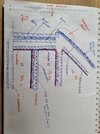Have brick-built barn, which has been previously converted by putting timber studding about 30cm from inner brick wall and covering with Kingspan.
2 of the rooms are at angles to the rest of the building and are much colder, both single story with vaulted ceilings. Both have huge draughts behind the Kingspan, which is the cause of the cold.
When I look in and up through an access hatch, I can see odd bits of plant growing through from the outside into the void (now removed) but it suggests strongly that there is simply a gap all the way up to the roof, and that the wind gets under the roof (necessary for ventilation in that space, I believe), but then whistles around the walls too.
So, how do I better stop the draughts? do I fill the upper gap, just below the soffits, with expanding foam to make it more airtight for the walls itself - or do they need the draught for ventilation? I understand I can't use cavity wall insulation as it's pressing against timberframe and plasterboard, and I'm not able to remove the walls for any other sort of fix.
I've made it better by ensuring the back boxes are fitted well so there are fewer draughts into the room itself, but the walls themselves are noticeably colder than in other parts of the house.
2 of the rooms are at angles to the rest of the building and are much colder, both single story with vaulted ceilings. Both have huge draughts behind the Kingspan, which is the cause of the cold.
When I look in and up through an access hatch, I can see odd bits of plant growing through from the outside into the void (now removed) but it suggests strongly that there is simply a gap all the way up to the roof, and that the wind gets under the roof (necessary for ventilation in that space, I believe), but then whistles around the walls too.
So, how do I better stop the draughts? do I fill the upper gap, just below the soffits, with expanding foam to make it more airtight for the walls itself - or do they need the draught for ventilation? I understand I can't use cavity wall insulation as it's pressing against timberframe and plasterboard, and I'm not able to remove the walls for any other sort of fix.
I've made it better by ensuring the back boxes are fitted well so there are fewer draughts into the room itself, but the walls themselves are noticeably colder than in other parts of the house.


